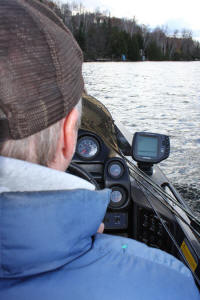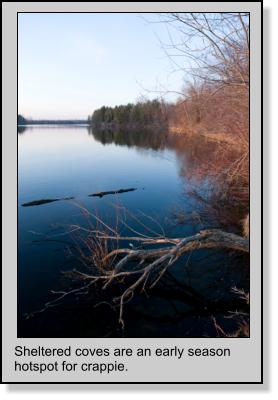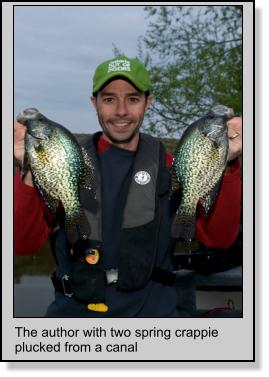|
 Fishing
Faux Pas – Strategies for Upping Your Odds Fishing
Faux Pas – Strategies for Upping Your Odds
By Justin
Hoffman
Overcome these common obstacles and challenge yourself to catch more
fish.
Putting fish in the boat on a consistent basis is easier said than
done. On the one hand we have unavoidable external factors - such as
the mood of our quarry – that is ultimately out of our control. But
what about the bad habits and mistakes we routinely bring to the
lake? Subconscious or not, these ‘negative’ traits often become a
detriment to our angling success, costing us a bend in the rod on
many of our outings. Plain and simple – mistakes are a deal breaker
in the game of fishing.
Overcoming bad habits and recognizing the mistakes you commit can
help lead you to more fruitful days on the water. Now is the time to
forge forward with new habits and break the bad ones of yesteryear.
Think of them as your new fishing resolutions for 2011.
Putting Too Much Faith in Confidence Baits
We all have our favourite lures. Those with the hearty teeth marks,
scratched paint and weathered look. The baits we rely on day in and
day out – comfortable to cast, easy to use and responsible for
hooking that giant of a fish some six years back. Turning to
confidence baits is one of the most common mistakes we commit as
anglers. And we are all guilty of it.
Changing your mindset and forcing yourself to get away from your
comfort zone when it comes to lures will increase your catch rates
greatly. And really, what’s the point in lugging that massive tackle
box if you’re only going to stick with one or two lucky charms?
Learn to become proficient with a variety of lures and techniques
this season. Building confidence in other baits can only come about
by using them. One of the best ways to accomplish this is by taking
a handful of new lures out on your next outing. With ‘old faithful’
sitting at home, you will be forced to spend the day with something
new – and this in itself is what builds confidence. In no time
you’ll feel comfortable and proficient with a wide range of lures,
allowing you to adapt to any situation you face and ultimately feel
comfortable throwing what is bound to get bit.
For those struggling with change, give yourself a set amount of time
to work a single lure. Use a stopwatch if it helps. If you’ve fished
without a sniff for fifteen or twenty minutes, then switch up
presentations and try something else. This is the best way to break
your habit.
 The
Sunshine Syndrome The
Sunshine Syndrome
Raise your hand if you’re a fair weather fisherman? It’s not a
surprise that a large percentage of anglers schedule their time on
the water to revolve around favourable and pleasant weather
patterns. Many see comfort far outweighing the merits of catching
more fish. For those that have limited days on the water, such as
many of the weekend warriors, this train of thought can negatively
impact how much we get to enjoy our favourite pastime.
It’s far too easy to say, “boy is it windy!” or “way too wet” and
have a day on the water slip you by. Even more so when you consider
that many of our favourite game fish bite better when the weather
turns a little nasty, including ‘ole marble eyes.
Force yourself to fish in less than favourable conditions this
season. Inclement weather will often turn fish on, leading to
invaluable feeding windows and better-than-average bites. You’ll
also face less angling pressure, which is a bonus for you and the
fish.
The most important thinking is to be prepared. Get a drift sock, buy
reputable rain gear, and utilize your trolling motor or kicker to
better work for whatever Mother Nature throws at you. Challenging
your comfort level is key to overcoming the syndrome. You may not
come home with a tan, but you might bring a trophy of a lifetime
with you.
Keep in mind that safety always comes first. If it is unsafe to
venture on the lake then please don’t do so. But don’t let a little
wind, rain, or the cold – and the weatherman for that matter - keep
you from having fun.
Sonar Un-Savvy
Sonar’s offer a wealth of fishing information that is invaluable
when working the water. And just like their moniker suggests, they
really do find fish.
 But
how many of us are truly using these units to their full capability?
Sure they come with a myriad of bells and whistles, but each one
serves a useful purpose. But
how many of us are truly using these units to their full capability?
Sure they come with a myriad of bells and whistles, but each one
serves a useful purpose.
Over the years I have witnessed far too many anglers rely on their
sonar for one thing – and that’s to show the depth. Big mistake.
How about using the temperature gauge to locate the warmest water
when seeking pike in early spring? Or using the zoom function to
dissect bottom structure and differentiate between various
compositions of weed and rock? Better yet, mark those pods of
baitfish that are suspended on the screen and waypoint it with the
GPS to work over on a trolling run for trout. Or last but not least,
pinpoint and mark that offshore hump found miles away from shore;
keying-in on the subtle breakline gradient and finessing the visible
fish hunkered down on the bottom.
Fish finder manuals are thick in nature for a reason, and soaking in
the abundant information will allow you to better understand, and
more importantly, better utilize your graph when out on the water.
Most offer real-time and on-screen tutorials, where your fingers can
control the action and give you a feeling for real-life scenarios –
all before you put your knowledge into use on the water.
Sonar technology has grown in leaps and bounds over the years.
Staying current with these advancements can only mean one thing, and
that’s more fish in the boat.
Turning Your Back on Detail
Attention to detail can have a significant impact on the amount of
fish we catch, or more importantly, those that we are able to hook
and ultimately land. Since beginning the fishing game we’ve all had
the same advice drilled into us – sharpen your hooks, check your
line and knot strength, or reapply fish attractant regularly.
Subconsciously we all know these ‘to-do’ items are necessary, but
putting them into practice and making them a part of our regular
routine can often be lacking.
 Get
into the habit of sharpening your hooks every thirty minutes and
also after every fish or snag you encounter. It doesn’t take much to
weaken the point on a hook, or create a burr, so being proactive in
this department can really make a difference when that next fish
decides to strike. In the greater schemes of things, it takes less
than ten seconds to put a perfect point on a hook – an intangible
amount of time for the hours you spend casting a line. Get
into the habit of sharpening your hooks every thirty minutes and
also after every fish or snag you encounter. It doesn’t take much to
weaken the point on a hook, or create a burr, so being proactive in
this department can really make a difference when that next fish
decides to strike. In the greater schemes of things, it takes less
than ten seconds to put a perfect point on a hook – an intangible
amount of time for the hours you spend casting a line.
As for line, check the first few feet after every fish and every ten
minutes when working heavy cover. Running your lips or fingertips
quickly along the length can alert you to any weak spots – sure
signs of a lost fish if left unnoticed. As for knots – get in the
habit of retying at least every hour. Strength can deteriorate
fairly quickly depending on the use and pressure we put on our line,
and like they say, the weakest link between you and a fish is always
your mono, braid or fluoro.
A quick shot of fish scent should be applied every fifteen minutes –
if anything, it will mask the handling of your lure and boost the
confidence in the bait you are using. For some species it can mean
the difference between getting bit and not.
Attention to detail can run the gamut in everything we do on the
water and isn’t only limited to line and hooks. When you think about
it, bad habits are all about staying in our comfort zone. For
instance – how do you cover a shoreline? We all know it is best to
work into the wind for better boat control, to have greater control
of our casts and to not blow by productive structure too quickly.
But for some anglers, it is ‘easier’ to drift down a shoreline, make
half as many casts and move to the next spot on the lake. An
avoidable mistake for the most part.
Pay attention to the detail side of things next time on the water.
They can range from small to big, but each can affect our fishing
success, and many require us to only get in the habit of doing them.
Same Old, Same Old
How many of us launch the boat into an expansive river or lake yet
fish the same handful of spots time and time again? This is another
common mistake we make as anglers and it can really handicap us when
it comes to catching fish.
Searching out new water can lead to great treasures, and some of my
best fishing spots have come by way of exploration. Set a goal of
fishing one new area each time you hit the water – no matter what.
If the spot produces, add it to your list. If it fizzles, keep it in
mind to try again during a different time period, in another season
or when weather patterns are considerably different.
The aim of this exercise is to discover the entire body of water, or
as much of it as you can. Because, when the fish aren’t biting in
your handful of favourite holes, you’ll need to know your way around
the water to put those fish in the boat.
Make it a personal mission to fish at least three new bodies of
water this coming season. Part of the fun of fishing is exploring
new fisheries and figuring them out. Unfortunately, bad habits often
keep us tied to the lake closest to home. Branch out this year and
break out of the mould – because really, the ‘same old, same old’
can get a little anti-climatic after a while.
Lack of Mental Alertness and Concentration
Concentration is a key aspect of successful angling. When a big fish
strikes, being alert and ready for battle will up the odds in your
favour. Make each cast count, work the bait to your utmost capacity
on each and every retrieve (sloppy casts or half-hearted cranks of
the reel will not suffice), and mentally be in the game for your
time out on the water. Trophy fish are a rare breed, so think of the
‘next cast’ as being the ‘one’, and you’ll lessen the chance of
losing her – or missing the strike completely – when she finally
comes out to play.
Opt for a healthy breakfast the morning of your outing. I know,
tough to turn your nose up at greasy bacon and sausage, but
nourishment that won’t make you lethargic will make a big difference
in giving you an athlete’s edge.
Staying hydrated can also be a key factor. A hot sun and lack of
water can wreak havoc on your system – interfering with mental
alertness, your ability to set the hook lightning quick, and
ultimately, being completely and 100% in the game.
Stock up on healthy snacks for the boat and watch your concentration
levels climb.
Mistakes in fishing can be common, but those that are preventable or
result from bad habits can greatly diminish our overall success.
Learning to identify and strengthening your faux pas - by
fine-tuning and adjusting your approach - will lead to more fruitful
days on the water. And that, my friends, is what the sport of
fishing is all about. Here’s hoping your fishing resolutions make
you a better and more proficient angler this coming season.
Check out Justin’s new website/blog at:
www.justinhoffmanoutdoors.wordpress.com.
The Action's In The Sheltered, Shallows
Protected, sun-drenched, shallow-water areas that fit the
Three Cs are the VIP lounges of the spring paper-mouth party.
They’re comfortable, bustling with activity, and well-stocked with
hors-d’oeuvres. This is because they’re the first areas to warm
after ice-out. Spots on a northern side of a water system can be
particularly good as they receive the most sunshine, and are
protected from cold, north winds.
To go a step further, look for soft, dark-bottom areas. Like solar
panels these zones absorb the sun’s energy. Dirty water and decaying
plant materials can have a similar heat-soaking affect. Don’t get
put off by the muddy appearance; this is ground-zero for the feeding
festivities.
The abundant sunlight that coves, creeks and canals receive
increases their water temperature. This stimulates the food chain.
Plants grow and give off oxygen. Aquatic insects also get
rambunctious as fly hatches loom in the near future. In turn, the
boom in food and warmer water attracts baitfish. Crappie follow,
moving shallow to chow-down on invertebrates and minnows. The Three Cs all provide
a cornucopia of crappie edibles and when combined with the right
habitat they’re prime early-season spots.
to chow-down on invertebrates and minnows. The Three Cs all provide
a cornucopia of crappie edibles and when combined with the right
habitat they’re prime early-season spots.
Coves
I think of coves in a nautical sense when it comes to
spring crappie. These are sanctuaries hidden from winds and open
water. On blustery days these inlets are relatively tranquil. Not
all coves are created equal though when it comes to alluring
crappie.
Bullrushes and reeds boost a cove’s property value. The winter’s
snow and ice will have pushed over a lot of their stalks and the
result’s prime cover for crappie and a multitude of insects and
minnows. Add some sunken or standing wood and the area’s even
better. Healthy weeds are always good to find in coves. They attract
crappies and their forage alike.
Some coves feature an inflowing creek. The warm meltwaters and the
various foodstuff creeks carry appeal to panfish. Finding these two
components together often means you’ve located a prime fishing spot.
 Creeks Creeks
Still to slow-moving creek arms are other great spring-time
spots. Fallen or submerged, standing trees are crappie magnets. Look
for timber that’s outside of a creek’s main flow. There also tends
to be a lot of debris floating in creeks during spring. Expect
branches and other pieces of cover that collect this refuse to hold
fish.
Undercuts are another hotspot. Add some wood cover and you’ve hit
pay-dirt. The shelter and space of these two combined elements
appeals to crappie. Bullrush-lined inlets and pockets are also good
bets on creeks.
A word of warning, rain and subsequent increased water flow can
temporarily set back fishing quality. Once the system stabilizes,
creeks will crank out catches again.
Canals
Several different types of canals are paradise for crappie in
spring. One type is constructed to expand waterfront property and
create sheltered docking space for land owners. Another is a trench
created for agriculture irrigation. Bullrushes, stumps, healthy
weeds, and old dock pilings will all hold fish in these dug-outs.
Another type of canal is designed to connect lakes and feature
locks. These robust structures attract crappie in spring, before the
gateways begin their open-water operation. The stone walls of these
structures serve double duty. They block wind but also absorb the
sun and radiate its heat. Regardless of style, the best canals have
little or no flow, helping them quickly warm-up and retain their
temperate water.
The initial weeks of spring crappie fishing can be fantastic. To
boost your catches, position yourself on the prime real-estate of
the Three Cs and focus on woody and weedy cover. Give early-season
crappie fishing a go this season. It’s tough to beat the fun of
landing slabs in the warm spring sunshine. .
*Tim Allard of Ottawa, Ontario is a hard-water expert and
author-photographer of the newly released book, Ice Fishing: The
Ultimate Guide. For information visit:
www.helipress.com/product/ice-fishing-138.cfm
Editors & Publishers
T.J. & Monique Quesnel
|
The
Ontario Fishing Network
E-Magazine is
published 12 times a year on or near the beginning of every month. Our
magazine is geared to any angler who enjoys fishing of any type in the
wonderfully diverse province of Ontario. Editorial Submissions: We welcome query letters,
but assume no responsibility for unsolicited materials. Subscriptions: Subscriptions are FREE of charge
and delivered via email.
You can subscribe
HERE: Privacy Policy: Unlike other publications We
NEVER make our subscribers list (your email address) available to any
other companies. Advertising: If you are interested in advertising
please email us. Circulation - 13,000 email subscribers
© 2011 Due North
Marketing / Ontario Fishing Network / T.J. Quesnel. All rights
reserved. Reproduction of any material without prior written
permission strictly prohibited. |
|